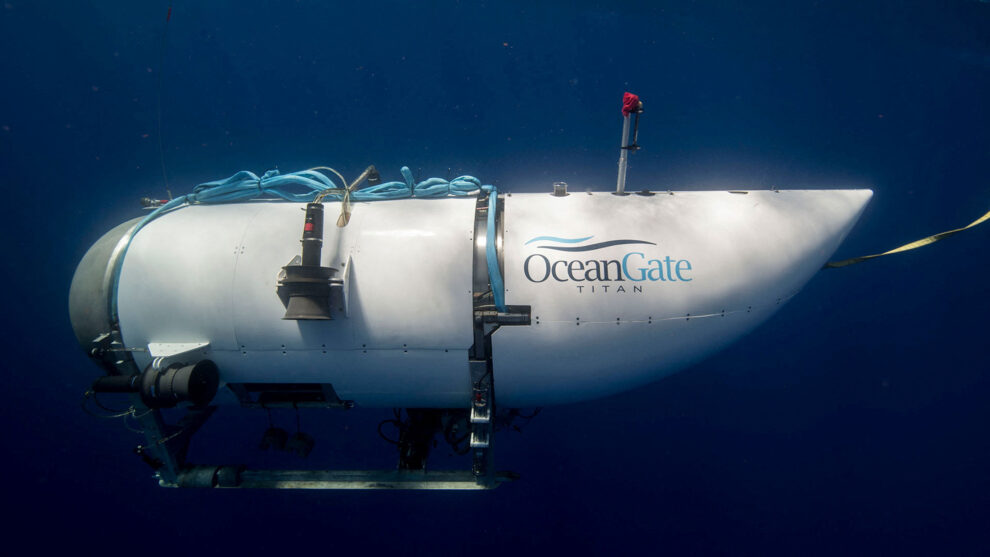Search operation attempts to explore origin of noises picked up by sonar buoys on Tuesday, as more vessels due to arrive at site
The source of underwater noises in the search area for the missing Titan submersible is still unknown, the US Coast Guard said on Wednesday, as more vessels were due to arrive at the site.
R Adm John Mauger, who is heading the search for the Titan, confirmed an aircraft had detected noise in the water picked up by sonar buoys on Tuesday, but said: “We don’t know the source of that noise.”
He said there were a lot of metal objects at the site of the Titanic wreck, which could be where the noise was coming from.
Mauger also told CBS News that the search operation would continue “as long as there’s an opportunity for survival”.
The discovery on Tuesday led search teams to relocate their underwater robotic search operations “in an attempt to explore the origin of the noises”, the Coast Guard said earlier in a series of tweets. The searches by remotely operated vehicles (ROVs) came up empty-handed but would continue, the Coast Guard said.
Authorities are scrambling to find the Titan, which went missing on Sunday during a dive to the wreck of the Titanic. On Tuesday, officials estimated the five people onboard had about 40 hours of breathable air remaining.
The Coast Guard’s announcement came after US reports citing internal government memos said banging sounds at 30-minute intervals had been picked up by crews searching for the submersible, and after an explorers’ organisation said “we understand that likely signs of life” had been detected.
Search aircraft with underwater detection capabilities picked up a banging sound every 30 minutes for several hours, CNN and Rolling Stone reported, citing US government memos. The emails did not make clear when the sounds were picked up.
The sounds were still heard after four hours, reported CNN, and said an update sent on Tuesday night suggested more sounds were heard, though they were not described as banging.
“Additional acoustic feedback was heard and will assist in vectoring surface assets and also indicating continued hope of survivors,” CNN quoted the updated government memo as saying.
In a statement on Tuesday night, the Explorers Club – which lists missing British billionaire Hamish Harding as a founding member of its board of trustees – thanked those behind the rescue effort, and said: “We have much greater confidence that … there is cause for hope, based on data from the field – we understand that likely signs of life have been detected at the site.”
Later, the New York-based club told the Guardian that they were “waiting for updates from the Coast Guard” before commenting further on reports that noises were detected in the search area.
Those onboard Titan for the tourist expedition are believed to be Harding, 58; Pakistani-born businessman Shahzada Dawood, 48, with his 19-year-old son Suleman, who are both British citizens; French explorer Paul-Henri Nargeolet, 77; and Stockton Rush, founder and CEO of OceanGate Expeditions. Authorities have not confirmed the identity of any passenger.
On Tuesday afternoon, US Coast Guard Capt Jamie Frederick said a giant sea and air search covering 20,000 sq km (7,600 sq miles) of remote ocean had “not yielded any results”.
Fresh equipment and craft, ranging from undersea recovery vehicles to hyperbaric chambers, have been sent to boost the rescue effort as estimated oxygen levels in the submersible run lower.
The US navy sent a deep ocean salvage system called Fadoss that was expected to arrive in Newfoundland on Tuesday evening, a US spokesperson told CBC News in Canada. It was due to arrive along with other equipment and personnel.
On Tuesday night, three US air force C-17 aircraft were confirmed as having landed in Newfoundland carrying equipment headed for the search area, 370 nautical miles (685km) to the south-east.
The Fadoss system is designed to provide “reliable deep ocean lifting capacity of up to 60,000lbs (27,200kg) for the recovery of large, bulky, and heavy sunken objects such as aircraft or small vessels”. The missing Titan submersible weighs 10,432kg (23,000lbs).
The recovery system has previously been deployed alongside a US navy remotely operated vehicle called Curv-21, the Cable-controlled Undersea Recovery Vehicle, a 2.4-metre (8ft) craft that can operate as far down as 6km (20,000ft). However it is unclear if it is being deployed for this search.
The Royal Canadian Navy ship HMCS Glace Bay was en route to provide a medical team specialising in dive medicine, as well as a six-person mobile hyperbaric recompression chamber. It was expected to be on scene by midday on Thursday.
The Canadian Coast Guard Ship (CCGS) John Cabot was expected to arrive later on Tuesday, the CCGS Ann Harvey was en route, and the CCGS Terry Fox was at the launch base in St John’s, Newfoundland.
Magellan, a British firm that specialises in deep ocean investigations and recovery operations, said it was supporting the rescue mission for the Titan.
A French research ship carrying its own deep-sea diving robot vessel was also being sent to the search area at the request of the US navy and was expected to arrive on Wednesday night local time, the Ifremer research institute said.
Source: The Guardian















